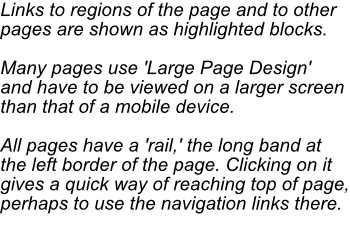
Introduction
A
defence of rhyme
Final-initial
rhyme
Centred
rhyme
Repeated sound
Free
rhyme
Rearrangement and restoration
The meaning of sound patterns
Rhyme, alliteration and assonance, often examined separately, in isolation, are all instances of linkage by sound, of course. Linkage by sound can be in accordance with a systematic scheme or pattern, for example a regular rhyme scheme. The systematic schemes and patterns have received far more attention than unsystematic linkage by sound. Unsystematic linkage by sound, intended or unintended, is very frequent in poetry, as for example in the first two lines of Yeats' poem 'The Second Coming:'
Turning
and turning in the widening gyre
The falcon cannot hear the falconer;
a later line
Reel shadows of the indignant desert birds.
and the last two lines
And what rough beast,
its hour come round at last,
Slouches towards Bethlehem to be born?
contain linkages by sound of consonants, shown by the use of a different font in a larger size in bold print. The internal consonants of a word, not only the initial consonants, as in alliteration, can be linked by sound. See my poem The Matterhorn for an unusually extensive use of alliteration - every word in the poem has initial 'w.'
The use of rhyme can have a beneficial effect on a poet’s technique. It sets a challenge. Since rhyme can have a mechanical effect and has associations from the past, the onus is on the poet to avoid these pitfalls by deflecting attention from the ends of lines, by using rhythmic subtlety and by using a diction which is not at all dated or hackneyed (always remembering that modern diction of a certain kind will quickly become dated.) A distinctively modern procedure in rhymed poetry is to establish a linkage by sound and at the same time to make the linkage not an obvious one, even to deflect attention away from the linkage. Alternatively, there may be a tension between the obviousness of the rhyme and the unexpected diction.
Some kinds of poetry seem almost to demand the use of rhyme, for example, humorous and light poetry. All my humorous and sarcastic poems, which include The Worst Restaurant in the World, are in rhyme. It would be difficult to name a large number of humorous and light poems in free verse, in 'language poetry' or 'linguistically innovative poetry,' although the poetry of e e cummings is an example.
The past associations of rhyme, the past associations of other literary techniques, quotation or near-quotation from a writer of the past, should not always be avoided in a contemporary poem. Modern squalor can be vividly realized by contrasting it with past beauty. Eliot did exactly this in The Waste Land, and made the contrast more effective by the allusion to Spencer: ‘Sweet Thames, run softly till I end my song.’ There are many other contrasts which would show past ages rather than our own in an unflattering light, and which would have the effect of making Eliot’s viewpoint over-simple.
Rhyme
can create a disturbance. It can express a disturbing vision. It is also a
way of creating contrast. In the study of rhyme, attention has been focussed
on the line endings linked by rhyme, but also important is the contrast between
what rhymes and what does not rhyme. In general, when a linkage is established,
a contrast is also established.
This poem of mine patterned by sound is surely a fully contemporary poem:
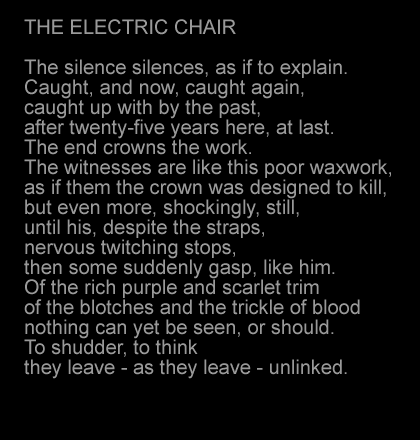
35s (This is the timing for the poem.)
A technique I sometimes use is the insertion of a punctuation mark such as a comma in a common phrase, altering its significance. In the poem above, the common phrase 'To shudder to think' becomes 'To shudder, to think...'
The next poem is seemingly more conventional - the impression of conventionality reinforced by the simple sound-linkage scheme aa bb cc ... but the appearance is deceptive. An earlier version:
The revised version. The few changes seem to me to be obvious improvements.
The calm, blue sea of sky
still saturated with light
unites the drifting island
of the sun, the particles of sand.
Glittering shoals of stars swim in the
mechanical sky, constantly
replenished and netted and landed,
brought to the land precisely when
demanded.
The mass beyond below
is where you may land, outlandish,
and so
like landed fish you'll gasp
at what you can't hope or fail to
grasp.
The poem makes a contrast between the regularity and predictability of nature and the unpredictability of the experience when the troops land on a D-day beach for the invasion. (But the stunning opening of the flawed film 'Saving Private Ryan' is just one reminder that the experience went well beyond unpredictability.) The orbits of the stars can be predicted by means of scientific theories. The philosopher of science Karl Popper compared these theories to 'nets:' "Theories are nets cast to catch what we call 'the world': to rationalize, to explain, and to master it. We endeavour to make the mesh ever finer and finer." The stars are constantly replenishing themselves by nuclear reactions, but a subsidiary association comes from myth, the 'Miraculous Draught of Fishes,' Jesus supposedly bringing into being fish when those he would make into 'fishermen of men' were unable to catch any. The stars sink in their apparent motions towards the land ('are landed') when predicted by the laws of celestial mechanics. (The sky is 'mechanical.') The phrase 'particles of sand' is used instead of 'beach' to reinforce the scientific background to the poem. The particles of sand which make up a beach are so numerous that they are intimations of infinity and infinity can be contrasted with the finite experience of humanity. The sun's apparent motion through the sky is its drifting, but without associations of aimlessness. This is a technique which I sometimes use - insisting on some of the associations of a word or phrase, deliberately excluding others. This is an instance of the {theme} {restriction}.
The time is evening, just after sun has set (the sun has sunk into the sand, there is now no separation between sun and sand.) It is too early to see the 'glittering shoals of stars.' They are imagined, remembered or conceived in scientific terms. Although there is plenty of light left (the sky is still 'saturated with light') darkness is increasing. The departure of the troops is now not a distant event but is fast approaching.
Their landing place is 'beyond' but also 'below' because it lies below the horizon. When they land, the troops will 'gasp at what they can't hope or fail to grasp' because the experience they face is bound to be complex. More exactly, the troops 'may land,' because they may be killed or injured, unable to land. Although the operation is so huge that they can only grasp a small part of it and they can't hope to grasp any more, they can't fail to grasp some of it, an essential part, by intense personal experience. These are aspects of human finite experience.
Compare this poem with a poem I read a long time after writing it: Yeats' poem 'Three Movements,' from 'The Winding Stair and Other Poems:'
Shakespearean fish swam
in the sea, far away from land;
Romantic fish swam in nets coming to the land;
What are all those fish that lie gasping on the strand?
The next poem I quote, a poem which gives voice to the sufferings caused by The Industrial Revolution, isn't a fully contemporary poem in itself. It may be that its technique is appropriate to the evocation of a remote era:
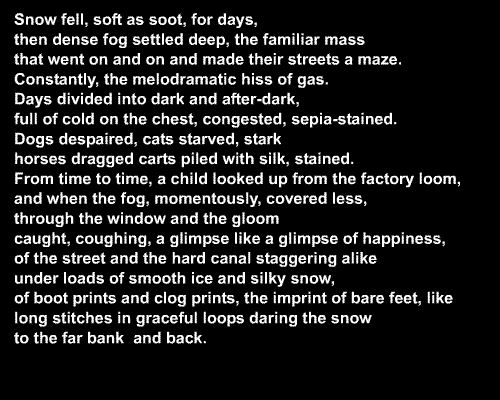
The poem contains a form of alliteration which I call diversified alliteration: the common device of alliteration is extended by diversification. (For 'diversification,' please see the General Glossary.) Alliteration is first generalized and then particularized. Alliteration is regarded as an instance of the general principle of linkage by sound and then other particular instances of the general principle are derived. In alliteration the initial letter is repeated. In line 7 of the poem above the variant instance makes use of not one letter but two letters and not the initial two letters but the final two letters of 'cats.' The letters 'ts' are inverted and the resulting invert, 'st' appears as the initial sound of 'starved.' Alliteration then follows, with the use of 'stark' following 'starved.' The 'st' sound has been anticipated by use of the word 'stained' in line 6 and the sound is confirmed by use of the word 'stained' in line 8.
Conventional alliteration may be used in routine way, one unsuitable for contemporary poetry, but there are distinctively contemporary uses of alliteration. One possibility is to use alliteration in a way which is excessive. Deliberate excess as a technique in contemporary poetry I refer to as 'nimiety.' An example is the use of a poem in unit form which is not given on this site, 'The Matterhorn,' in which every word begins with the letter 'w' except for the one word 'once,' a sustained exercise in alliteration which is intended to be more than just an exercise. The term 'nimiety' is used by Coleridge. It's applied by Basil Lam in his study of the Beethoven String Quartets, with reference to a repeated phrase in the Quartet Opus 135. It can be applied to the whole of Beethoven's Grosse Fuge, Opus 133.
I intend this poem concerned with The Industrial Revolution to be superimposed on a painting which makes use of the technique of Colour Stain Painting introduced by Helen Frankenthaler and a development of Colour Field Painting, the technique of soaking paint which has been diluted into the unprimed canvas. The use of the word 'stained' in lines 6 and 8 is relevant.
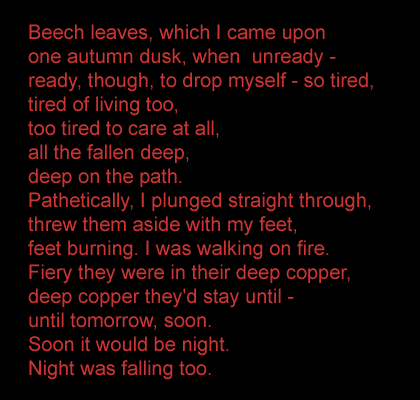
The technique of linking by sound the final word or phrase of a line with the initial word or phrase of the next line - unlike most sound-linkages between lines, which use 'final-final' rhyming - is used by Louis Macneice in 'The Sunlight on the Garden,' but unsystematically and in a restricted way. The first two verse paragraphs:
The sunlight on the garden
Hardens and grows cold,
We cannot cage the minute
Within its nets of gold,
When all is told
We cannot beg for pardon.
Our freedom as free lances
Advances towards its end;
The earth compels, upon it
Sonnets and birds descend;
And soon, my friend,
We shall have no time for dances.
In this poem, I systematically link all the lines using final-initial rhyme.
A note on 'copper.' Copper had homely connotations of heat in Britain in the past - a copper, 'a large vessel, formerly of copper, used for boiling ...' (Collins English Dictionary.)
Centred
rhyme
There is no need for a poet to be dependent upon established rhyme schemes.
Others can also be used. In centred rhyme, the first line rhymes with the
last, the second line with the penultimate, and so on, until at the centre
of the poem there are two adjacent lines which rhyme, or, alternatively, a
single line which rhymes with no other.
The rhymes at the centre and near the centre will be prominent, the effect becoming fainter as we move towards the top and bottom margins of the poem. There will be a sound gradient from the centre to these margins, lines which are distant from the centre hardly being perceived as rhyming. This technique gives a method of varying the impact of rhyme. If the rhymes at the centre are disturbing, there will be a disturbance at the heart of the poem which gradually dies away.
Two examples of poems using centred rhyme:
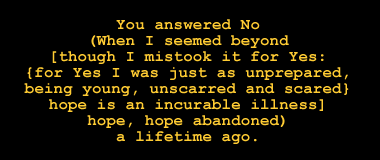
This poem is not autobiographical. The 'No' is a refusal to enter into a relationship, although I recognize that this interpretation isn't established in the poem. The poem makes use of the very rigorous unit form.
Fields
unlike fields,
snowed under, in the dark.
Stark, staring, standing snowflake -
near, no other -
watching, watching the whiter than white,
strong, silent fields of another
fielding flakes,
caught out by the cold, the dark
wilderness of the fields.
This poem describes an uncommon act of concentrated attention by using common phrases - 'stark, staring' (as in 'stark, staring mad'), 'snowed under' (as in 'snowed under with work'), 'whiter than white' (used to describe someone very pure and flawless), 'strong, silent' (as in 'the strong, silent type'). There's imagery from cricket: 'fielding,' attempting to catch out the ball of the batsman. The fields - cultivated and artificial to that extent, have been transformed into a wilderness.
The {distance} between rhymes is an important consideration not only in centred rhyme but also in other contemporary poetry which is patterned by sound. When words at the ends of lines rhyme, the two variables which must be considered are {distance} apart and {distance} of degree (directness and obviousness or otherwise of the rhyme.) If ‘dear’ is rhymed, in a very direct way, with ‘hear’ and the rhymes are at the ends of adjacent lines, then this can be described as dear, hear (2). The figure in curved brackets refers to the {distance} l between lines. (I use a different notation for rhymes within the lines.) Rhymes which are proximate as well as direct are often, but not always, inappropriate in a contemporary poem. If the rhymed words are separated by two intervening lines, ie dear, hear (4), then the rhymes can still be described as proximate but are less direct. More likely to be useful in a fully contemporary poem are dear, hear (8), where the rhymes are linked and separated more widely (the interval is greater), and dear, dare (2). In a poem in centred rhyme, more direct rhymes may be employed in the periphery of the poem (for example, in the first and last lines) and less direct rhymes may be used in the central lines, aa in the sound scheme above. This modifies the sound gradient, introducing tension.
I developed the technique of centred rhyme without knowing that it had already been used by Don Paterson in 'Landing Light' in the poem 'America:'
All
afternoon we stood watch on the wharf
for what might now be summoned and evicted
till one wave slowly turned and curled and sickened
and boked up a man. He hung there for a second
and somewhere in that second was perfected
then came apart and fell into the surf.
The rhyme scheme is a b c c b a.
I've now found Tim Love's observation (it can be found on the page http://www2.eng.cam.ac.uk/~tpl/asp/) that Dylan Thomas also used the form: 'Dylan Thomas was disappointed when people failed to notice that a poem of his had the first line rhyming with the last, the 2nd with the penultimate, etc.'
Its use in individual stanzas dates back many centuries. George Herbert's 'The Gifts of God' uses it. This is the first stanza:
When
God at first made Man,
Having a glass of blessings standing by;
Let us (said He) pour on him all we can:
Let the world's riches, which dispersèd lie,
Contract into a span.
The rhyme scheme is a b c b a.
The opening of Robert Frost's 'Desert Places:'
Snow falling, and night falling fast, oh, fast
In a field I looked into going past,
And the ground almost covered smooth in snow,
But a few weeds and stubble showing last.
The images conveyed by the image-terms are memorable, unforgettable, suave and soft, in very effective contrast with the emphatic rhythm, but for all that this opening line is imperfect. The obvious imperfection is the fact that 'fast' at the end of the line has a sound linkage with 'past' at the end of the second line and 'last' at the end of the fourth line, a sound linkage not nearly so subtle as it should be, the kind of sound linkage found in doggerel, in fact.
Less obviously, the sound linkage of 'falling,' 'falling,' 'fast,' 'fast' gives undue prominence to the 'f' sound, which is not nearly as effective as repeated 's' sounds, but the 'f' sound set up in the first line is linked very successfully with the 'f' sound in 'few' in the fourth line. The weeds (and stubble) are dry, bedraggled: this is not conveyed by the 'f' sound so much as aided by the 'f' sound. And, of course, 'smooth in snow,' a component of the very effective 'almost covered smooth in snow' does provide the satisfying, if obvious, assertion of the 's' sound.
I sometimes use 'rhyme clusters.' Here, the rhyme {distance} (within the line) is very short - the rhymes are adjoining. An example is the beginning of my poem 'To a lyric poet,'
Useless
- less - unless distress
drives or drove your work.
Useless - less - unless success...
The poem 'The Matterhorn' makes use of repeated sound in every word - alliteration extended to an unusual extent. I discuss the poem in the page on concrete poetry.
Why,
Whymper,
will we wish
we were where we
'whither?' wondering
why Waste weeds windowed
Will worn well-welter-white?
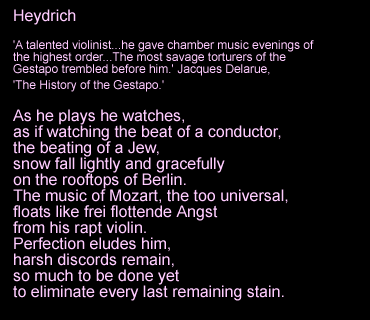
Usually, when poets have linked lines by sound, they have used 'systematic' rhyme schemes such as aa bb ..., abba ... and abab ... Linkage by sound can also be achieved by using a less regular scheme, as in the example above, where the 5th, 8th, 10th and 12th lines are linked by sound.
Comments on matters other than sound: Heydrich became known as 'Hangman Heydrich' and played a prominent part is the 'Final Solution.' He was assassinated in 1942. We have to imagine Heydrich not playing in chamber music with an audience but practising alone, and able to look through a window at the delicate snow and the heavy rooftops of Berlin. Mozart is 'the too universal' because he could be appreciated by contemptible people: a fact but of course not a criticism of Mozart. 'frei flottende Angst' is the psychoanalytic 'free- floating angst.' Mozart's music to many people expresses, very often, a sadness akin to angst. Heydrich's idea of perfection combines the aesthetic with the deranged and perverted view of groups as 'undesirables' who have to be eliminated to achieve 'perfection.'
Poetic language is often more sensuous than non-poetic language, as, almost always, in Keats, but it may also be more schematic than everyday non-poetic language. This schematic language will sometimes seem abstract and sometimes bare and elemental, powerful and direct rather than abstract. Cezanne's practice gives strong support for schematism. Cezanne took the human body, a still life or landscape (above all, Mont Sainte-Victoire in Provence) and distorted appearances and modified tonality in order to achieve a pictorial balance, but, more than that, a 'realm of pure being.' (Richard Verdi: 'Cezanne.') George Heard Hamilton refers to Cezanne's 'organizing intelligence.' ('Painting and Sculpture in Europe 1880-1940')
These are techniques which are not just applicable to rhyme. In the case of rhyme, the syntax of a poem can be adjusted in order to reduce the rhyme {distance}. (In the case of rhymed couplets, aa, bb, cc... the {distance} is 2 and the rhymes are proximate. In the rhyme scheme abba, cddc the {distance} is 4.) As a result of rearrangement, rhymes become closer, as in this example:
He
wrote
by rote,
and said that he,
and said that we,
will always convince,
will be convinced by -
his daring
us to be unconvinced.
'he' is brought into close rhyme with 'we.' I refer to this technique as rearrangement of rhyme. Two lines are separated from their natural successors. The words 'and said that he' have as their successor 'will always convince' but they have been separated from it. The words 'and said that we' have as natural successor 'will be convinced by' but are also separated from it. The regrouping has the effect of making the rhyme more direct by reducing the interval. Restoration gives the syntax and the word order of non-poetic prose. In the example above, restoration gives the sense, 'and said that he / will always convince' and 'and said that we / will be convinced by.'
In the next poem there are two successors to red (below) and blue (above): this is the time when sunset is giving way to night and the red colour is contracting, the blue is expanding.
Not
even, evening:
below, a glow,
red, redder, reddest,
above, sky-blue -
contracts, expands,
soaring above the lives
in the houses in the forest,
shuttered, almost invisible,
waiting for blue-fingered night.
'Blue-fingered' - the night being very cold - is an allusion to Homer's 'rosy-fingered dawn'). The words 'contracts, expands' gain in force and contrast by being placed next to each other. Restoration gives a version which has less impact:
Below,
a glow -
red, redder, reddest,
contracts,
above, sky-blue,
expands ...
This is also a region poem. There are three regions: the houses in the forest, the contracting region of the setting sun and the expanding blue of the night sky.
Word-chains (or 'concatenations') often emerge as a result of rearrangement. This particular word-chain is not part of a poem, and not part of of a potential poem:
'Remarkable, neglected, unjustly, long.'
The reference is to Martin Seymour-Smith's Guide. The concise word-chain has greater impact than the restored, slightly amplified equivalent, Martin-Seymour's Guide is a 'remarkable, lengthy work which is unjustly neglected, and has been neglected for a long time.'
Several lines may have one, common successor, not several successors, as in this example, where the successor is in the final line.
In
-
or out of -
or severe -
or very near -
danger.
So, 'In -' doesn't have its own unique successor, it has the same successor as the next three lines: 'danger.' Restoration gives 'In danger,' 'or out of danger ...'
This
is an instance of free rhyme: which is the counterpart of
'free verse.' Rhyme can be used systematically, following a rhyme scheme,
or unsystematically, perhaps only once or twice in a poem. In the poem above,
there is no rhyme scheme and only 'severe' and 'near' are linked by sound.
The
meaning of sound patterns
Pattern by meaning and pattern by sound may both be used in the same poem. Lines which are linked by sound may also be linked by meaning or contrasted by meaning. ‘Love’ rhymes with ‘dove,’ and also with ‘shove,’ but obviously the meaning linkages are very different.